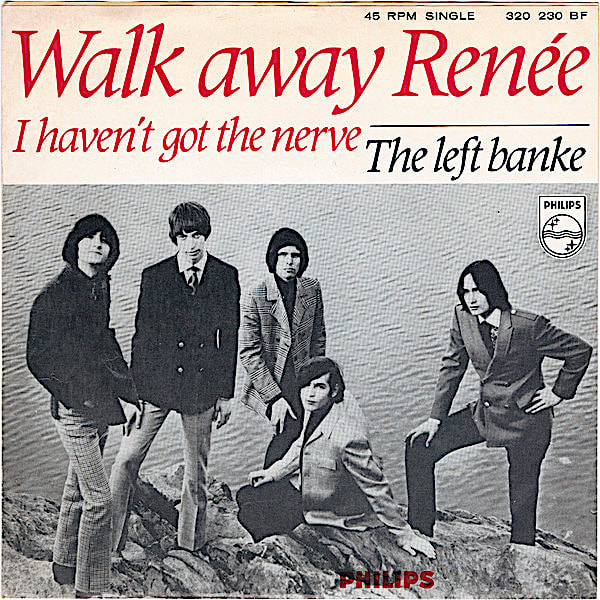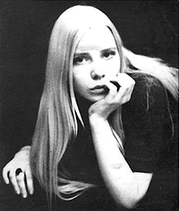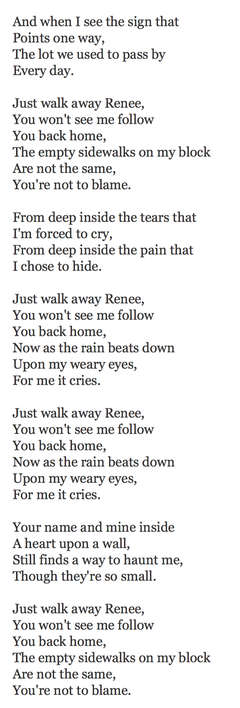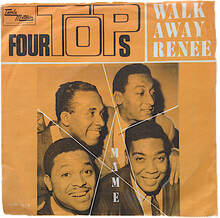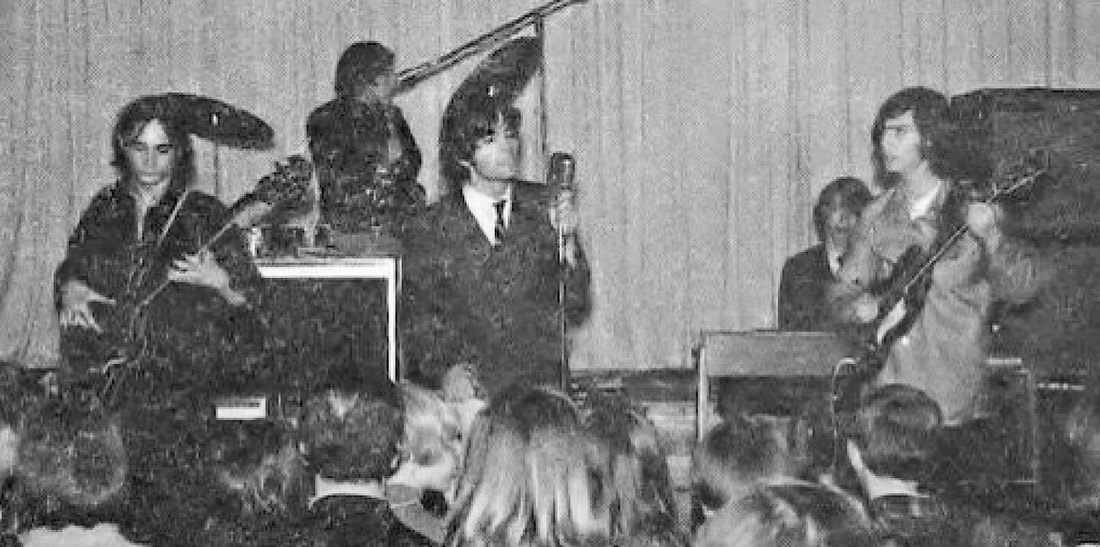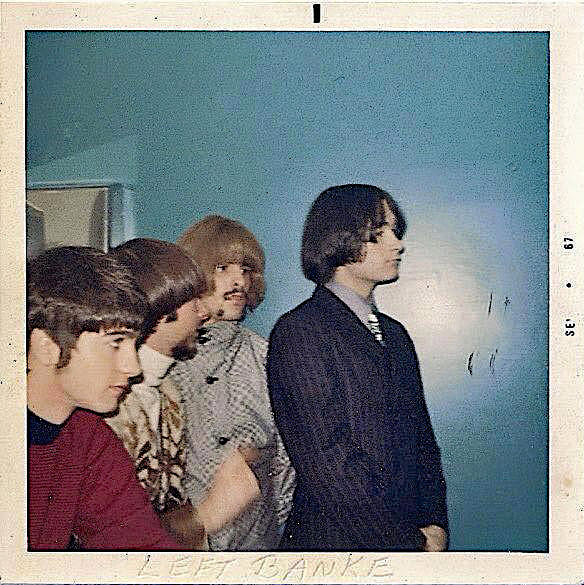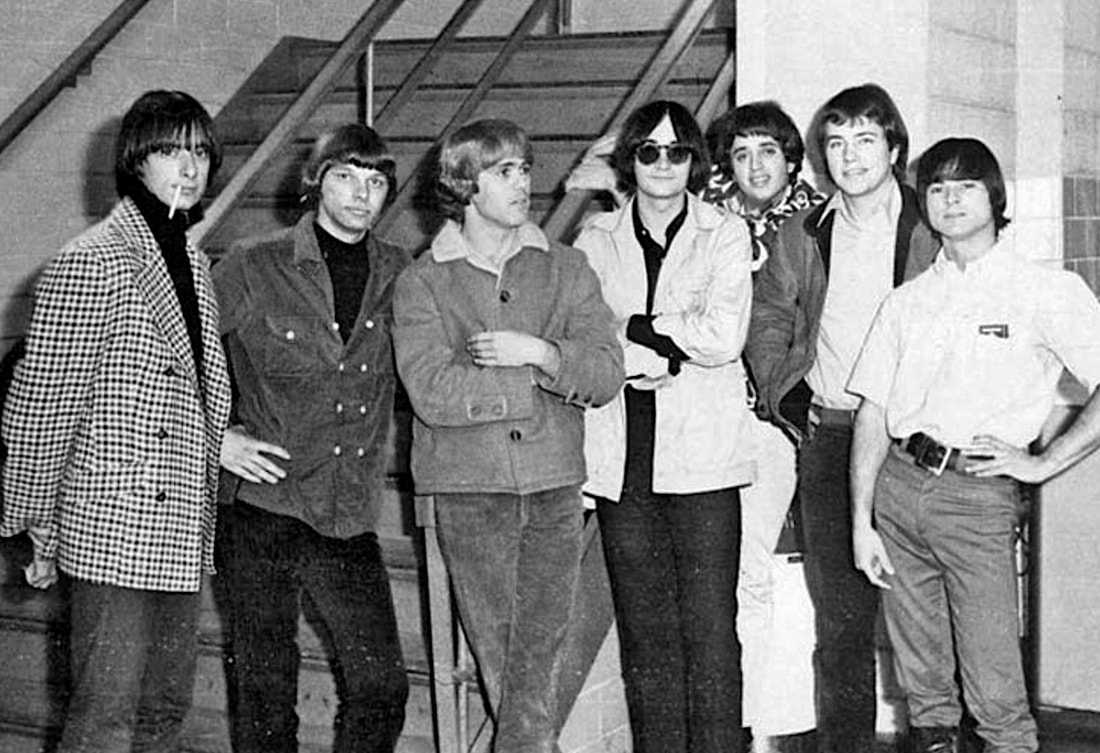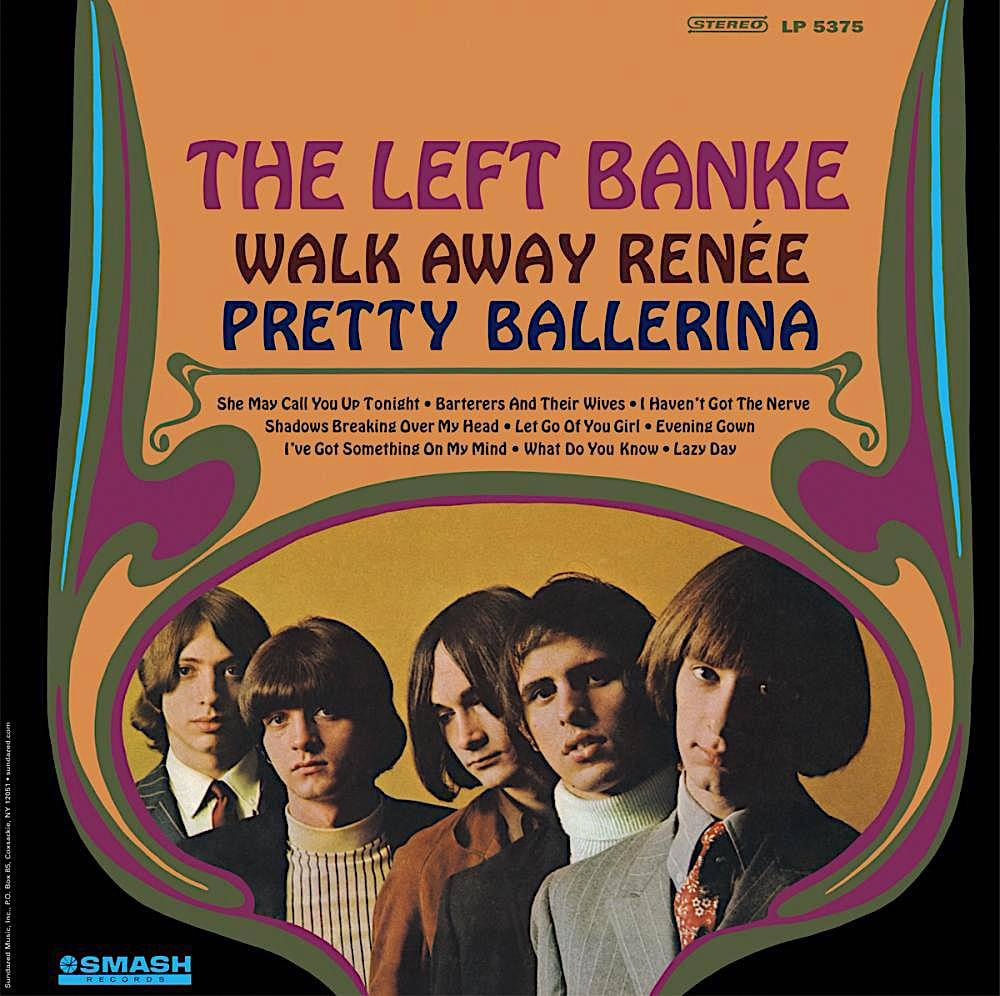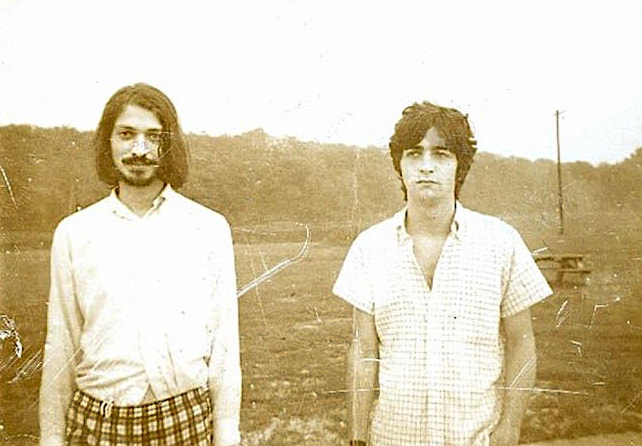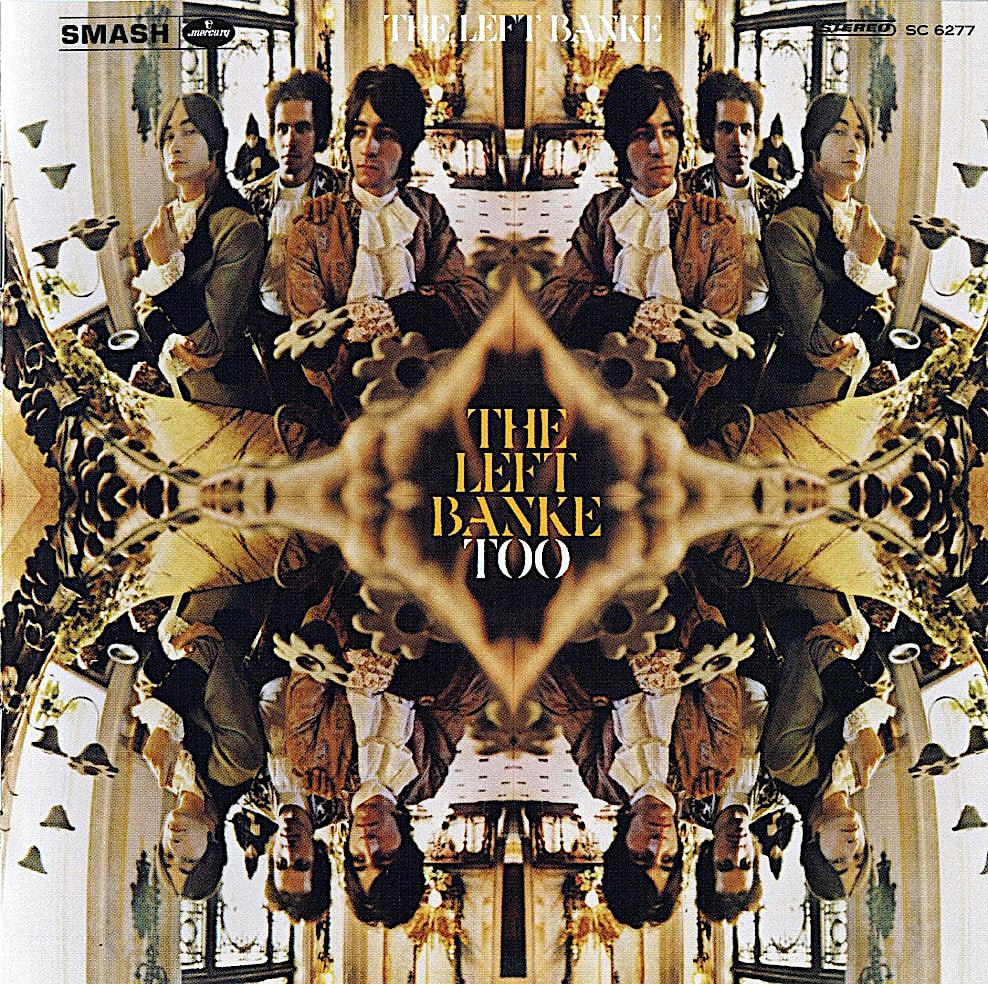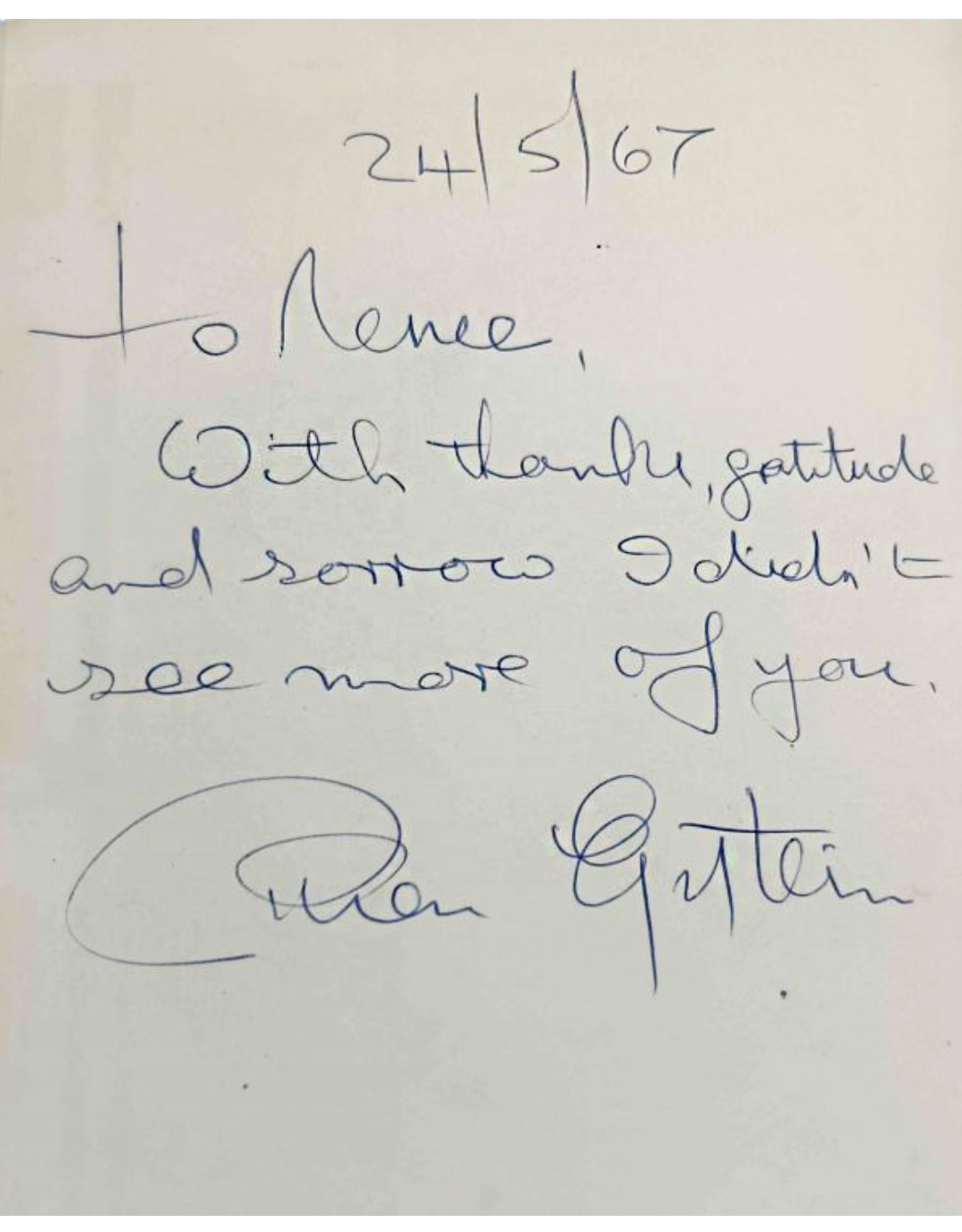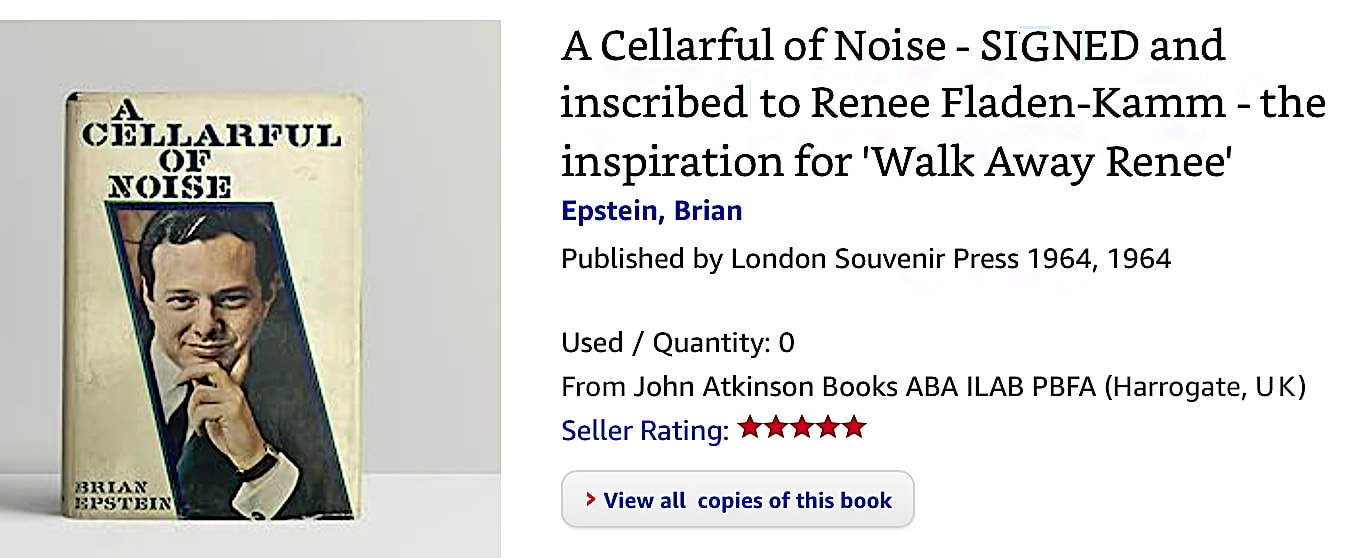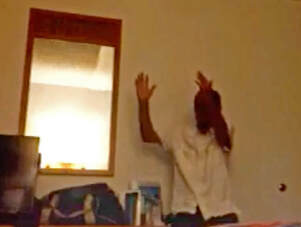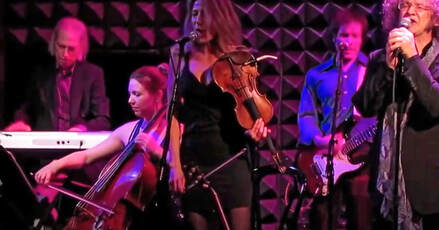|
Sometimes in life a small thing will catch you off guard and leave you slightly ruffled. Pop music can do that and in my experience does it regularly. Recently, while listlessly cruising around Youtube I hit on the video for a 2011, live-in-New York version of “Walk Away Renée” by a latter-day version of the Left Banke, the band who'd written and released the original hit in 1966. I've loved the record since it first came through my transistor decades ago, and when I occasionally hear it again out of the blue, it sounds as luminous as ever. So I played the Youtube video but with low expectations, and in many ways those low expectations were met, the sound is muddy and the pitch is wobbly. Inevitably too, on this imperishable song of youthful heartache the band's two surviving frontmen are showing their age, not horribly so, just inescapably, like my own reflection. Yet, despite any reservations I was moved, not for reasons of pathos or nostalgia – for me the song's enduring appeal is not tied to any time or place – but because these guys were set on performing this great record as faithfully as they could. It mattered to get it right. This started me thinking over what I'd learned about the song through the years, and how I'd followed the work of one band member in particular well into the 1970s. What I already knew was intriguing enough, so I looked further.
|
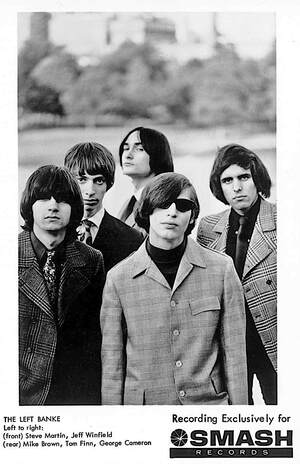
The Left Banke came together in New York over several months through 1964-65, with guitarist Tom Finn being the main catalyst. In '64 he met Steve Martin Caro, son of a flamenco dancer and a bullfighters' agent, who had recently arrived from his native Madrid, outside the City Squire Hotel where the touring Rolling Stones were holed up. Along with another friend, George Cameron, they hung out together in the East Village and regularly hit Steve Paul's Scene club on 46th Street. Finn's group The Magic Plants (“I'm A Nothing”) had worked with producer Harry Lookofsky at World United studios on Broadway, and the last and most crucial of Finn's introductions resulted in Lookofsky's son Michael joining the others in impromptu jams around the studio piano. According to Finn, Michael Brown, as he called himself, was “this classic closet-case intellectual kid from Great Neck who had taken piano lesson from the time he was four”. Brown had the keys to World United where he worked in various capacities for $35 a week, eventually doing some writing and playing keyboards for Reparata and the Delrons who were managed by his father. At first it was mostly about the fun and the singing, and Finn, who had worked Brooklyn street corners with a vocal group called The Castles, tightened the harmonies. Their fooling around with Zombies, Kinks and Beatles songs in the studio caught the attention of Brown's father. Lookofsky particularly noted Steve Martin's lead vocal potential, and no doubt, the group's teen appeal with all the girls hanging around the place during these long impromptu sessions. He'd had some success with Reparata and the Delrons in their early phase and probably saw in this boisterous bunch of kids another chance at hit records and big time management. With his father's encouragement Michael became the writing focus of the original Left Banke line-up which started recording at World United around the middle of 1965.
They settled on the Euro-flavoured band name, spelling Banke with an 'e' to “be noticeably different from any First Nationals”, as they later joked to Teen Set magazine, and the songs started coming. The British Invasion-influenced “I Haven't Got The Nerve” and “I've Got Something On My Mind” were recorded around the middle of 1965 and shopped around various labels with no success. It's surprising that these tapes didn't drum up more interest because the quality is already showing, but pop music was a feverish, fast changing marketplace in the mid-60s and a lot of unpredictable and barely controllable factors could determine what cut through and what didn't. Having your tape hit the desk of an A&R man who really knew what to look for was a long shot.
With Michael being the band's only more than competent musician at the time, apart from Magic Plants drummer Warren David, session players were used for most of the backing; although in the usual way, these things remain a bit murky depending on who's talking. The drummer suddenly took off for California when things didn't seem to be heading anywhere interesting, and Michael Brown sold his coin collection and went with him to try out the music scene on the Coast. Finn says David was in fact kicked out by Harry Lookofsky in part because of his bi-sexuality and generally being a bad influence, and with Brown still only 16 and a minor, Lookofsky had him stopped at the airport in LA and sent back to New York.
Despite this unpromising environment of record label rejections and band personnel on the run, just when things seemed to be falling apart, something gelled. While Brown was away Cameron, Martin and Finn had polished the vocals on a song which already had a promising demo on tape, and was re-recorded with session man Al Rogers copying David's drum part. Lookofsy was a professional violinist who sometimes played jazz under the name Hash Brown, and knew proficient and affordable classical players who could sit in. On the final arrangement a brief string intro sets up the first verse's undulating melody and the vocal harmonies give just the right lift to the plaintively urging chorus. A flute solo in the bridge nicely enhances the mood, and before long another Left Banke tape was ready to shop around. In July 1966 “Walk Away Renée” was sold to Mercury Records who released it on their subsidiary Smash label. It soon picked up airplay in Pennsylvania, Ohio and beyond and headed for the charts. That's when things took off, and soon after, that's when the trouble started.
They settled on the Euro-flavoured band name, spelling Banke with an 'e' to “be noticeably different from any First Nationals”, as they later joked to Teen Set magazine, and the songs started coming. The British Invasion-influenced “I Haven't Got The Nerve” and “I've Got Something On My Mind” were recorded around the middle of 1965 and shopped around various labels with no success. It's surprising that these tapes didn't drum up more interest because the quality is already showing, but pop music was a feverish, fast changing marketplace in the mid-60s and a lot of unpredictable and barely controllable factors could determine what cut through and what didn't. Having your tape hit the desk of an A&R man who really knew what to look for was a long shot.
With Michael being the band's only more than competent musician at the time, apart from Magic Plants drummer Warren David, session players were used for most of the backing; although in the usual way, these things remain a bit murky depending on who's talking. The drummer suddenly took off for California when things didn't seem to be heading anywhere interesting, and Michael Brown sold his coin collection and went with him to try out the music scene on the Coast. Finn says David was in fact kicked out by Harry Lookofsky in part because of his bi-sexuality and generally being a bad influence, and with Brown still only 16 and a minor, Lookofsky had him stopped at the airport in LA and sent back to New York.
Despite this unpromising environment of record label rejections and band personnel on the run, just when things seemed to be falling apart, something gelled. While Brown was away Cameron, Martin and Finn had polished the vocals on a song which already had a promising demo on tape, and was re-recorded with session man Al Rogers copying David's drum part. Lookofsy was a professional violinist who sometimes played jazz under the name Hash Brown, and knew proficient and affordable classical players who could sit in. On the final arrangement a brief string intro sets up the first verse's undulating melody and the vocal harmonies give just the right lift to the plaintively urging chorus. A flute solo in the bridge nicely enhances the mood, and before long another Left Banke tape was ready to shop around. In July 1966 “Walk Away Renée” was sold to Mercury Records who released it on their subsidiary Smash label. It soon picked up airplay in Pennsylvania, Ohio and beyond and headed for the charts. That's when things took off, and soon after, that's when the trouble started.
|
Renée Fladen. About a year
before the recording of "Walk Away Renée". Below: The lyrics to "Walk Away Renée". The song's credits are given in various ways. On this version they are: Music by Michael Brown. Lyrics by Michael Brown, Bob Calilli, Tony Sansome. Four Tops single on Tamla Motown.
The Left Banke onstage circa 1966, with Jeff Winfield on guitar, right.
Fan snapshot, c.1966.
Mingling with the Electric Prunes, 1967.
Debut album on Smash. Released January 1967. Tracks recorded December 1965 to January 1967.
Michael Brown and Steve Martin, 1967.
The second album on Smash. Released November 1968. Tracks recorded
late-1967 to 1968. A Curio: not so long ago this entry appeared on the second-hand book site, abebooks.com.
The item for sale is a copy of Brian Epstein's A Cellarful Of Noise (1964) given by Epstein to Renée Fladen-Kamm, with an inscription on the fly-leaf. The sale price is not revealed. |
The back story to the creation of “Walk Away Renée” has been retold many times and it's de rigueur to mention it in any article on the band, because it's irresistible – so here we go again. The Renée in question was Renée Fladen, Tom Finn's girlfriend, although he lost her to Warren David before David was kicked out. She was, it seems, a captivating blond of Swedish descent who lived part time with a bunch of “half-runaways” in a crash pad around Tin Pan Alley. Finn brought her to the studio one day: “For a kid of 16 or 17 she was just sort of free and liberal and open-minded, sexy, everything. A very bright young girl.” In light of all that, Michael probably didn't stand a chance – he was instantly smitten and out of those unexceptional circumstances of unrequited love came a timeless record. “I was just sort of mythologically in love, if you know what I mean”, said Brown years later, acknowledging that if he'd had a more intimate relationship with Renée the song would never had happened. “As a matter of fact, like the twilight zone or something, if you cross over you lose what you have. It was only because I was away from it that I could appreciate the beauty of it.” In other words, if I understand this right, consummation might've resolved the frustration, but diminished the intensity and desire which brought out the song. He said that he couldn't record his keyboard parts while Renée was in the control room, “my hands were shaking”, and had to come back later. It was all just too complicated and in the song he “wanted her to walk away because it made it easier”. Before long Renée did just that, leaving behind the NY scene and the pressure of all this attention.
It's also thought that Renée Fladen inspired Brown to write the band's successful (#15) follow-up “Pretty Ballerina” although she wasn't a dancer, and “She May Call You Up Tonight”. The latter flopped as a single and I first heard it when I found a second hand copy of the band's debut album in the early 70s. I've always thought that the record's infectious hook, its nuanced if a little confusing expression of that ol' eternal triangle, and its sheer formal beauty, make it one of the great lost hit singles of its era. I played the track several times the day I got the LP home. In Brown's lyrics for “Walk Away Renée” the mundane neighbourhood details, the sign that points one way, the empty lot, are eloquent metaphors drawing on recollections of playing as a child on Falmouth Street, Brooklyn, near where he grew up. The song was a blend of his current infatuation and his childhood memories, while avoiding (just) being overly sentimental. But wait… one of the song's co-writers has said that this long accepted narrative is all nonsense. Three people get writing credits for “Renée”, Michael Brown, Bob Calilli, and Tony Sansome (not to be confused with the bodybuilding icon). In July, 2016, the National Catholic Register website posted an interview with Sansome on the 50th anniversary of the record's release. In 1966, the 27 year-old Sansome was working as a career songwriter obssessed with classical music, and he crossed paths with the Left Banke at World United studios. Having contributed to both “Walk Away Renée” and a small part of “Pretty Ballerina”, he takes credit for the Puccini-inspired structure, the "descending chromatic bass melody", the use of flute and harpsichord and “a raft of strings and chimes”. Curiously, I've come across no discussion of his contributions in other interviews and Brown has said the Mamas and the Papas' “California Dreaming” gave him the idea for the pastoral flute solo. The sound engineer Steve Jerome and session arranger John Abbot have also been talked up by band members over time, not to mention dad Koolofsky's input – so who knows who did what? But Sansome goes much further, insisting that the widely accepted romantic back story is “completely untrue” and that he chose the name Renée after hearing the Beatles' “Michelle” and thought, “Why not another French name?” He adds: “The entire song was about my life in the Bronx – specifically, the things around me as I was growing up there. I saw the empty streets near my house and put that into my song”. Sansome says that he wrote all the lyrics except “you're not to blame”, and that he lived on a hill on 207th Street, which “I mention in the song”. It's worth noting that there is no hill mentioned in the song. Very strange. When asked what he attributes the song's staying power to he replies , “God – that's to whom I give credit for the song. I consider it a gift from God, a miracle”. A miracle… well there's some sort of truth in there, I feel, but the calibre of Michael Brown's other work on the debut album and several later recordings suggests more surely where the credit lies. “Walk Away Renée” hit #2 on the Cash Box Top 100, spent 13 weeks on the Billboard Hot 100, peaking at #5, and in my homeland New Zealand it also got to #5. The promos and music press abounded with “going for baroque” and “baroque and roll” puns in response to the harpsichord, flute and strings. Leonard Bernstein featured it on one of his TV specials to show us all how grown up pop music was becoming. There have been more than 50 official cover versions, not counting instrumentals, it received a BMI award for a million radio plays and it's heading for nine million hits on Spotify, for whatever such stats are worth. The band recorded jingles for Hertz, Toni and a pretty nice one for Coca-Cola. In 2004 Rolling Stone magazine rated it the 222nd greatest song of all time, flanked by "Walk On The Wild Side" and Howlin' Wolf's "Spoonful" – it has since dropped off the list. The cover version by the Four Tops was itself a respectable hit record, going as high as #3 in the UK where the Left Banke's single had actually failed. In my simplistic teenage view of things, my fondness for the original made me almost resentful that another act would try to move in, but I liked it anyway. However, to me the Four Tops seem to be outside the song, employing their robust style to fine effect, while the sound of the original grew naturally out of its circumstances and the tone is more that of a personal account. The Tops give it a brilliant reading, but I prefer the understated mood of resignation and release that the original arrangement with Steve Martin's vocal has. Michael Brown has said that the line about two names “in a heart upon a wall” was the only outright invention in the song, he simply needed a good third verse. “Still finds a way to haunt me, though they're so small” borders on the twee and sounds a little awkward from Levi Stubbs, yet I never thought so on the original… maybe that's just me. “Walk Away Renée” entered the Billboard Hot 100 at #69 with a bullet, and with Brown safely back in the fold and a solid set of originals and well practised covers, the road beckoned. The core Left Banke were Steve Martin (lead vocals), George Cameron (drums/vocals), Michael Brown (keyboards/main songwriter) and Tom Finn (bass/vocals). Everyone knew that before going out on tour they needed to improve the band's overall playing level and bolster the live sound, although even as a five or six-piece they would always struggle to cover for the string section and other studio elements. In a November '66 radio interview Finn, initially just a competent bass player, claims to play trumpet, drums, piano, harmonica and bass guitar, which might reflect some of this struggle, and resolve. “We sang and played from our hearts. We were still more of a vocal group trying to master our instruments, but we had strong ideas about what we thought was good,” and “We wanted to be the Beatles – but we also wanted to be as good as the Beatles”. On stage they covered a lot of UK material (there's a brisk version of Dave Clark's “Glad All Over” around), some R&B, and when all was going well their repertoire of originals built around Brown's intricate keyboard lines, and the covers drawing on the band's garage roots, worked just fine. Guitarist Jeff Winfield joined for only a few months before being fired by Lookovsky during the recording of the first album. To replace him Lookofsky auditioned Rick Brand who initially baulked at joining this “fag rock group”, until his own band had all their equipment stolen, so he decided to give it a go. Brand is on the Walk Away Renée/Pretty Ballerina album cover but only played on one track. Later, Emmet Lake, bearded keyboardist and music editor for the East Village Other, joined when Brown “pulled a Brian Wilson” and stopped touring to concentrate on writing and the studio. Lake was a good player but looked out of place amongst the Carnaby Street stylings of the others. Tom Feher, who eventually replaced him said Lake looked like one of the Fugs. Players came and went as tours with Strawberry Alarm Clock, the Association, the Beach Boys and Mamas and Papas, among so many others took their toll. The band sounded best when they were able to use first rate gear like the set-up the Beach Boys' carried around, or the night in Detroit when they shared an excellent sound system with a couple of Motown acts. Otherwise there were too many nights when they'd “regularly get [their] asses kicked by local bands with better equipment”. Yet there were enough good gigs and screaming audiences along the way to keep spirits up, for a while. The shy and moody Martin had the look and voice, and the playing got better, but their stage presence was erratic and as Brand says, while other bands “would be trying very hard to be likeable to the audience, we just didn't give a fuck”. Following the ascent of “Walk Away Renée” and the release of the album in January '67 (only reaching #67 and #59 on Billboard and Cashbox respectively), the ensuing months tell a story that's very familiar indeed – dodgy management, record company interference and then indifference, missing payments, personality clashes, Murry Wilson-style “father of the resident genius” issues, drugs, bad decisions and the “we were just kids” factor. They'd be paid $100 for a show after spending $75 on a limo to the gig just for the hell of it… that kind of stuff. Even deep into this period members talked earnestly of the group's vision and where they were heading, but in reality the ground was crumbling under them. That early period of excitement and adventure had soon turned sour. Michael Brown, always tending towards the brittle, couldn't handle the equipment problems and inter-personnel dramas any longer and left, so the band lawyered up and got rid of his dad, manager Lootofsky. Brown had told Teen Scene that he was working on a new album, a movie score, a Broadway show and some classical compositions! No wonder he took his beaten up clavinet out of the rental trailer where it was constantly going out of tune and headed home. And when Steve Martin also left, the end was in sight. Finn had once described Martin as “A born winner, but he doesn't dig publicity. He could quit right now and run off and get his pick of a hundred millionaire countesses on the Riviera”. A Martin-less version of the band toured into '69 until it inevitably petered out altogether, with no reports of Steve hitting the Riviera. Things got weird for a while when there were two Left Banke's, with a version forming around Brown that included Michael McKean, the future actor and Spinal Tap lead singer David St. Hubbins. Both bands released singles as the Left Banke, to the confusion of radio stations and the dismay of fan clubs. As far as I can make out, this is the seemingly terminal shambles into which “She May Call You Up Tonight” fell out of sight. Finn has said that some time during this period Donovan had told them the Beatles were breaking up and it seemed like an omen to him. They pulled the plug one day in Florida: “We just didn't want to compete in a Beatle-less world”, was Finn's much later and somewhat wistful afterthought, but it does suggest that with so much going wrong they felt the world they'd aspired to was slipping away. There was brief reconciliation in late-'67 between Michael Brown and the others as they worked, at the urging of Mercury, on an ambitious new single, “Desirée”. Brown is credited with the writing and the impressive production carried out in the big room at Capitol Studios, Sinatra's old stomping ground. But even the 17-piece orchestra, a lavish for the time $5000 budget, and another double-'e', couldn't make “Desirée” a hit when most radio stations, no doubt perplexed by recent events, remained unenthusiastic. The buzz around "baroque pop" had gone and as simplistic as it sounds, the original Left Banke's hit potential went with it despite their best work transcending such labels. Many people consider “Desirée” to be the band's best record. I can't quite agree of course, but it's a splendid thing, especially considering the accidental erasure of the multi-track master which left a mono reference tape as the instrumental base… although I think it shows, and the big chorus promises a little more than it delivers. Still, it deserved to do a lot better than briefly surfacing at #98 before dropping out of sight. I first heard it when I obtained a well worn copy of their second album The Left Banke Too from the US in the mid-70s. This post-Brown LP cobbled together tracks recorded by various line-ups through 1968, mostly under Lemon Pipers producer Paul Leka, and included “Desirée” which remains its centrepiece. The drawn out coda to the original flurry of success continued when in November '69 Brown and Martin released a single “Myrah” as the Left Banke, to no avail. In the meantime Brown had written and produced an album in his most limpid style for a band called Montage, including a less dense re-run of “Desirée”. Staying in character, Brown wrote probably their best song “I Shall Call Her Mary” for another major crush, Mary Weiss of the Shangri-Las – they'd reportedly shared an apartment at some stage. During the 70s the original line-up occasionally spluttered into life in one form or another, recording a couple of respectable tracks for the X-rated film Hot Parts that were released under Martin's name, because management thought “the Left Banke's name was poison, jinxed”. Even Michael's dad Harry Lookofsky returned to play violin on some 1972 sessions. Much better records were Brown's first two albums on Kama Sutra as a member of Stories, both of which I like. Stories didn't have a hit until after Brown had left and their cover of Hot Chocolate's “Brother Louie” from their second LP, About Us, went to #1 on both Billboard and Cashbox in '73. The Beckies were Brown's last serious roll of the dice as part of a band. Again, I had to import their 1976 album on Sire records, but was disappointed by its undistinguished power pop (a major genre push at the time) and even where Brown's touch is clearly evident, the old flair isn't. A few late-70s demos, the skeletal remains of a third Left Banke album, are out there somewhere on a comp called Strangers On A Train. The band members kept in touch over the years and worked on various demos and low-key projects, although Steve Martin seemed to struggle the most at holding things together, further involvement with the others being hampered by drinking and other problems. “The Left Banke was only a positive experience for a few months”, said Martin in later years, having reverted to Steve Martin Caro to avoid confusion with the comedian. He vowed to never sing “Walk Away Renée” again. The last publicly available image of Steve is a video from 2015 that looks to have been made in a Florida hotel room. His face in deep shadow and unrecognisable, he briefly tells of how he went to the Dakota building the night after John Lennon was shot, and the fear he felt while standing there. “The devil came out of the ground with Mark Chapman, and killed John Lennon. I felt the devil coming out of the ground… it was an environment of death!” Michael Brown also made an unusual video in 2005 and now on Youtube, describing how religion had relieved the anxiety of his bipolar disorder, and talking warmly about his family. In 1994 he had produced an album by his wife Yvonne Vitale, with George Cameron drumming. |
|
In 2011 Tom Finn and George Cameron put together the Left Banke who played in the video I mention at the start, with Michael Fornatale taking Steve Martin's vocals. There's a show by the same band from April 2012, at BB King's in Times Square with Brown being helped onstage to play “Pretty Ballerina”, and one from June 2013 at Joe's Pub featuring him on the set closer, “Walk Away Renée”, which the band introduce wryly with “let's do the good one”. Despite its fuzzy, phone-recorded image and sound, Brown's wraithlike form at the keyboard makes it a touching document, and he leaves the stage to the applause of all. This was the last time Michael Brown played “Walk Away Renée” live. He died a few months later.
Recorded in strained circumstances by a motley group of teens and industry journeymen, in the crazy hope of cracking a ruthless and fickle market, the story of “Walk Away Renée” was pretty much standard in the mid-century pop world. The fact that it succeeded musically and commercially in a way that very, very few records did, is why this story was endlessly repeated. You always believed you had a chance if you got enough things right through talent, determination, timing and dumb luck. The record's baroque trappings sounded novel enough in 1966 to spur a marketing catchphrase, and attract attention in a media eager for any signs of a new trend, an engaging quirk, a hook to hang an interview on. Today, with so much music reflecting our instant access to more or less all of history, the effect of the Left Banke's intuitive and ingenious use of the past seems less startling, and anyway the Beatles and Rolling Stones also released prominent songs in 1966 that mined a similar classical vein. Mid-60s pop was nothing if not eclectic. I think the Left Banke were so eagerly promoted as trend leaders at the time because they were American when a lot of innovation was coming from elsewhere, the baroque flavour wasn't a one-off and permeated several of their songs, and especially because the record itself was unusually compelling and satisfying emotionally. It's this last quality that matters in the long run. Today, the fleeting trendiness, personal discord, the errors and failures woven into the band's own history, are simply that, history… the record prevails. I say record rather than song, because it's the sound of that exquisite, 57 year-old Left Banke single that stays with me – small things still find a way to haunt us. ..................... Michael David Lookofsky a/k/a Michael Brown, died of heart failure in March 2015, aged 65. He's survived by his wife and their twin sons. George Cameron died in 2018, and with the passing of both Steve Martin and Tom Finn in 2020, the four original members of The Left Banke were gone. Renée Fladen-Kamm is a successful singer and vocal coach on the West Coast, specialising in Medieval music. Sources: various published interviews with radio stations, and with magazines including Hit Parader, Teen Beat and Teen Screen. Also, articles and obituaries in The Glasgow Herald and The Guardian, among others, and online websites including Please Kill Me, and the defunct leftbanke.nu in the Wayback archive. And, of course, Youtube and Wikipedia. |
